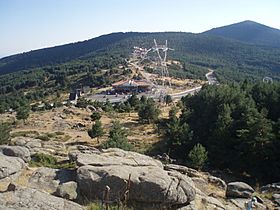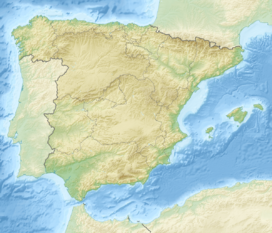Guadarrama Pass facts for kids
Quick facts for kids Guadarrama Pass |
|
|---|---|
| Puerto de Guadarrama Alto del León |
|

The cross at Guadarrama Pass.
|
|
| Elevation | 1,115 m (3,658 ft) |
| Location | Segovia Province, Madrid Province |
| Range | Sierra de Guadarrama, Central System |
| Coordinates | 40°42′36″N 4°8′25″W / 40.71000°N 4.14028°W |
The Guadarrama Pass (called Puerto de Guadarrama in Spanish), also known as Alto del León, is a special place in the Sierra de Guadarrama mountains in Spain. A mountain pass is like a natural pathway through mountains, making it easier to travel from one side to the other. This pass is part of the larger Sistema Central mountain range.
For a long time, the Guadarrama Pass has been a very important route. It connects the big city of Madrid with the northern parts of Spain. Imagine it as a key bridge that helps people and goods move across the mountains!
Where is the Guadarrama Pass?
This mountain pass is located in two different areas of Spain. On its northern side, it is part of a town called El Espinar in the Segovia Province. On its southern side, it is near the town of Guadarrama in the Madrid Province.
The pass sits in a valley between several tall peaks. To its south, you'll find the slopes of the Cerro de la Sevillana, which is about 1,556 meters (5,105 feet) high. Nearby, there are also the Cabeza Líjar peak, standing at 1,824 meters (5,984 feet), and La Peñota, which reaches 1,945 meters (6,381 feet).
The Guadarrama Pass is still a major travel route today. The N-VI highway, which connects Madrid to the city of Corunna, goes right through this pass. This makes it a busy and important road for many travelers.
History of the Pass
The Guadarrama Pass has seen important historical events. If you visit the area, you might find old bunkers and trenches. These are remains from the Spanish Civil War, which happened in Spain between 1936 and 1939.
During the war, this pass was a key battleground. One side, called the rebel faction, took control of the northern part of the mountains after a fight known as the Battle of Guadarrama. Another group, the Second Division of the Spanish Republican Army, was active in this area from December 1936 to March 1939. The remains of these structures remind us of the important role the pass played in that conflict.
See also
 In Spanish: Puerto de Guadarrama para niños
In Spanish: Puerto de Guadarrama para niños
- Central System


